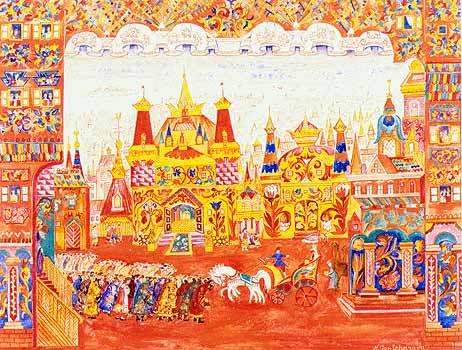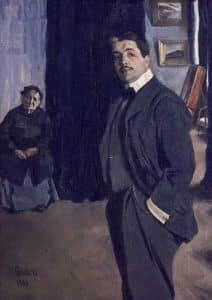
Sergei Diaghilev, Russian art patron, collector, impresario and director of the famed and controversial Ballets Russes, was born in 1872 to a wealthy and aristocratic family. During his childhood, he was no stranger to chamber music, soirees and serious conversations about literature and poetry, and as befitted his social status, he was sent to study law in Saint Petersburg at the age of 18. Soon realizing that he had no real affection for the profession, he found himself introduced to a circle of artists and writers through a cousin who was also living in the city. He graduated from Saint Petersburg State University in 1896, but found that he would rather follow a career in music, despite being discouraged in his endeavors by famed composer Rimsky-Korasakov. In 1906, he left Russia and began life in Paris where he contributed to the Franco-Russian artistic alliance, and in 1909 he founded the Ballets Russes.
The Ballets Russes went on to revitalize and revolutionize ballet through the integration of a variety of art forms including music and painting. It was comprised of dancers from some of Russia’s most influential and important Imperial Theaters, including Saint Petersburg’s Mariinsky and Moscow’s Bolshoi. The troupe included some of Russia’s most famous dancers, including Anna Pavlova, Tamara Karsavina, Alexandra Danilova and Sergey Lifar. The influence of the Ballets Russes on not only dance, but on fashion, design and the visual arts cannot be understated, as there was a great deal of collaboration between the different spheres of the art world. Indeed, the company was the first to involve professional artists rather than stage decorators. Involvement with the Ballets Russes propelled several Russian visual artists to international fame, and provided them with less-than-traditional outlets for their creativity. Costumes and stage designs were created by several well-known Russian artists, including Leon Bakst, Mikhail Larionov, Natalia Goncharova and Alexandre Benois, for whom a wing in Saint Petersburg’s Russian Museum is named. Several of the artists, including Bakst and Benois, were active in the Mir Isskustva (‘World of Art’) movement, as was Diaghilev himself. Some have even gone so far as to ask, “without Diaghilev’s creative genius, would Picasso, Matisse, Juan Gris, Leger, Marie Laurencin de Chirco, Miro, Andre Derain or Pavel Tchelichev ever have designed for the stage?” The influences of the Ballets Russes on the visual arts contributed to the trends towards both orientalism and the Art Deco movement in the 1910s and 1920s.
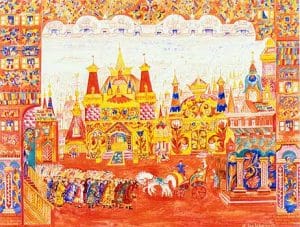
Several well-known Russian artists contributed heavily to the set design of the Ballets Russes, and they were in turn influenced by Diaghilev’s set and costume designs, which primarily integrated elements of primitivism, exoticism, cubism, futurism and constructivism. Natalia Goncharova, who contributed immensely to the set designs of the Ballets Russes, for example, is now considered to be one of the most influential Russian avant-garde painters. After several years of sculpting and the exploration of symbolism, cubism and futurism in visual arts, Goncharova traveled to Paris in order to complete stage designs for the performance of the Coq D’Or in 1914, but was forced to return to Russia later that year at the outset of World War One. She later re-joined Diaghilev in Geneva in 1915 to continue her work. The Ballets Russes were to significantly change the way in which she approached art, for it was at this time that she nearly completely abandoned traditional easel painting in favour of set design.
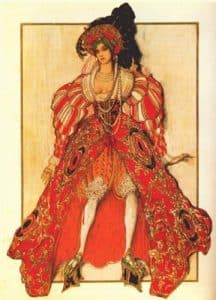
Leon Bakst, another major contributor to the Ballets Russes, was born in Belarus in 1866. He met Alexandre Benois in 1890 in Saint Petersburg, where Bakst had attended the Academy of Art until his expulsion in 1887 for presenting work that, like so many others at the time, was considered by the Academy to be too ‘unconventional’. While working as an illustrator of children’s books, he became a leading member of the Mir Iskusstva movement, and later worked as an art teacher in Saint Petersburg with such illustrious pupils as a young young Marc Chagall. During the early part of the century, Bakst mainly focused on portraiture, at which time he painted such cultural luminaries as Filipp Malyavin, Andrei Bely and Zinaida Gippius. Between the years of 1909 and 1921, he collaborated with Diaghilev on the Ballets Russes, where he found employment variously as artistic director, costume designer and set designer. Although Bakst had largely turned his attentions to Theater design by the beginning of the twentieth century, he continued to work in portraiture, which, combined with his work with the Ballets Russes, would define his career during the late 1910s and early 1920s. He rapidly became the Ballets Russes’ most prolific designer and artist, and his name quickly became inseparable from the group as the Theater work refined and developed his talents. It was this collaboration that propelled him to international fame, and in 1922, he traveled to New York in order to showcase an exhibition of decorative figures and portraits. Without a doubt, the highlight of this exhibition was a set of mural decorations presented in seven panels that Bakst designed for the grand salon of the Rothschild mansion in London. The panels “followed in the footsteps of the early masters in using modern portraits, those of the Rothschild family and of London society at large.” Seven years earlier, after Bakst shot to fame with the success of the Ballets Russes, Rothschild, then unknown to Bakst, approached the artist and commissioned the paintings, with the express instructions that the work remain secret until its completion. By 1922, Bakst had achieved enough international fame that his New York exhibition opened with a prestigious viewing by invitation only, and London’s Victoria and Albert Museum was already purchasing several of his works. Upon arrival in the United States, he received several portrait commissions, including one for the daughter of William K. Vanderbilt.
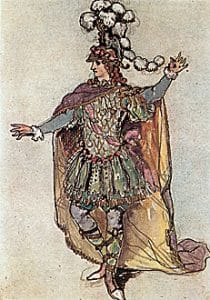
The third of several influential artists involved in the Ballets Russes is Alexandre Benois, a Russian artist and art director born in Saint Petersburg into a highly successfully artistic family of French ancestry. Similar to Leon Bakst, Benois was educated at Saint Petersburg State University’s school of law, but was destined to follow his artistic passions. One of the founding members of the Mir Isskustva movement, Benois attacked the standards of the Peredvezhniki (‘Wanderers’) movement and became quite influential in the world of Russian set design. Benois’ work was exhibited in 1905 at Diaghilev’s Salon d’Automne. Their collaboration was to last until 1924, when Benois split from the company. Benois’ involvement with the Ballets Russes forever changed his career path, as he largely began to focus his attentions on stage design and décor, and some of his greatest works were produced during his time with the Ballets Russes. In 1926, faced with the difficult life of an émigré or the increasingly frightening prospect of returning to life in the Soviet Union, Benois chose to pursue Theater work first in France at Paris’ Grand Opera, then at Milan’s La Scala Theater.
The Ballets Russes was far more than a simple ballet company, and Diaghilev was much more than a ballet director. Rather, the company was a meeting place where all art forms converged in one stunning production. Diaghilev, himself heavily involved and interested in the visual arts prior to his work with the Ballets Russes, provided an arena where artists could come together and work, and significantly shifted the trajectories of the careers of several leading Russian artists. He shot the artist Leon Bakst to international fame, for his work with the Ballets Russes brought him to the attention of Rothschild and provided him with a significant amount of work with some of the world’s leading families at the time. The Ballets Russes facilitated the departure of several Russian artists during the tumultuous times of the 1917 Russian Revolution and the nascent Soviet state, and allowed them to continue their work in exile abroad for decades to follow.
Source Material From:
Artnet.com; The Ballets Russes; Encyclopedia Britannica: Alexander Benois, Serge Pavlovich Diaghilev; Encyclopedia of World Biography: Sergei Diaghilev; Russian Ballet History; Russiapedia; Union List of Artist Names; Visual-Arts-Cork.com; Lessing Photo Archive; MoMA; Bertc.com; Wikipedia Images
“Leon Bakst Is Here to Show Paintings: Russian Artist Brings Collection of Decorative Figures and Portraits” in New York Times, 1922.
Oxford Art Online: Leon Bakst


